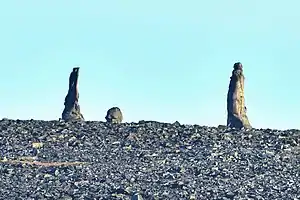Kigilyakh
Kigilyakh or kisiliyakh[1] (Russian: кигиляхи; Yakut: киһилээх, meaning "stone person") are pillar-like natural rock formations looking like tall monoliths standing more or less isolated. Usually they are composed of granite or sandstone shaped as a result of cryogenic weathering.[2] Most kigilyakhs formed during the Cretaceous period and are about 120 million years old.[3]
.jpg.webp)

Cultural significance and etymology
These anthropomorphic rock pillars are an important feature in Yakut culture.[4][5] Often they are slightly scattered, protruding from the surface of smooth mountains and giving the impression of a standing crowd of people.[6] According to Yakut legends kigilyakhs originated in very ancient people.[5]
The Yakut word "kisiliy" means "a place where there are people".[3] Kisilyakh means "mountain having a man" or "mountain married".[6] The term "kigilyakh" is a distorted form of the original Yakut "kisilyakh".[7]
Locations
Such stones are found in different places of Sakha (Yakutia), Russia, mainly in the East Siberian Lowland:[5]
- Alazeya Plateau
- Anabar Plateau
- Kigilyakh Peninsula, with Mount Kigilyakh and Cape Kigilyakh, Bolshoy Lyakhovsky Island, New Siberian Islands
- Kisilyakh Range, part of the Chersky Range[2]
- Kisilyakh-Tas, an isolated mountain located in the Kolyma Lowland, roughly 160 kilometres (99 mi) from the coast of the East Siberian Sea, on the right bank of the Alazeya River at 69°40′N 155°0′E.[3][8]
- Kyun-Tas
- Chetiryokhstolbovoy Island, Medvezhyi Islands, East Siberian Sea
- New Siberian Islands
- Oymyakon Highlands
- Polousny Range
- Stolbovoy Island, Laptev Sea
- Suor Uyata range[9]
- Ulakhan Sis[10]
Outside of Yakutia, similar formations are found in the island of Popova-Chukchina and the Putorana Plateau, in Krasnoyarsk Krai.[11]
History
Ferdinand Wrangel reported on the kigilyakhs on Chetyryokhstolbovoy, an island of the Medvezhyi Islands in the East Siberian Sea. He visited the island during his 1821-1823 expedition and named it after them (Chetyryokhstolbovoy meaning "four pillars"). The kigilyakhs on Chetyryokhstolbovoy Island are about 15 m (49 ft) high.[2]
In Soviet times on the Kigilyakh Peninsula at the western end of Bolshoy Lyakhovsky Island, one of the New Siberian Islands, Vladimir Voronin, then in charge of the Polar station on the island, was shown a large standing rock which had been heavily eroded and which gave its name to the peninsula.[12]
See also
References
- "Verkhoyansk & Kisilyakh". Archived from the original on 2021-07-30. Retrieved 2019-07-18.
- "Медвежьи острова". Brockhaus and Efron Encyclopedic Dictionary: In 86 Volumes (82 Volumes and 4 Additional Volumes). St. Petersburg. 1890–1907.
{{cite book}}: CS1 maint: location missing publisher (link) - Types of weathering
- Kigilyakhi of the New Siberian Islands - Russian Geographical Society
- "Kigilyakhi of Yakutia". Archived from the original on 2020-05-08. Retrieved 2019-07-18.
- Ландшафты как отражение топонимов Якутии (Landscapes as a Reflection of the Toponyms of Yakutia)
- Toponimy of Regional Cultural Landscapes – Verkhoyansk District, Sakha (Yakutia)
- Село Андрюшкино и его обитатели (Andryushkino village and its inhabitants)
- Кисиляхи хребта Суор-Уйята
- Ykt - Вернулись из Гранитных Городов Улахан Сис
- A. Grigoriev, Megaliths in the Arctic
- Soviets gather geographic data in Arctic - CIA
Further reading
External links
 Media related to Kigilyakh at Wikimedia Commons
Media related to Kigilyakh at Wikimedia Commons- Russian propaganda: Sacred anthropomorphic kigilyakh megaliths in northern Yakutia
- Yakutia – Russian Easter Island
- Protected Areas in the Russian Arctic
- Unknown landscapes of the planet. New photo expedition project. Yakutia.
- Якутия.Фото - Священные Киhиляхи в Верхоянском районе. Зимой / Ancient Siberian stones in Verkhoyansk Mountains. Winter (27 фотографий / 27 photos)